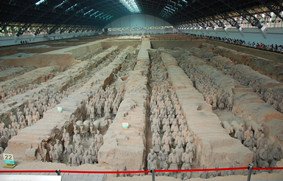 Brief Introduction
Brief Introduction
The Museum of Terracotta Warriors and Horses was set up upon the approval of the State Council in 1975, and was officially open to the public on October 1, 1979. It is the biggest on-the-site museum in China and exhibits thousands of terracotta warriros and hourses made by Chinese people more than 2,000 years ago. As one of the top ten places of historic interests in China, the museum was enlisted in the World Heritage by UNESCO IN 1987. It was considered as ‘the eighth wonder of the world’ and ‘the most spectacular archaeological finds of the century.
Background Knowledge:
Emperor Qin-the Owner of the Terracotta Warriros and Horses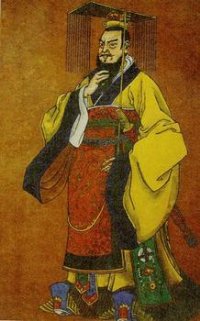
Emperor Qin (Qin Shihuang in Chinese) was originally known as ‘Ying Zheng’. He was born in 250 BC. At that time, China was divided into some small principalities and had been in a long time break-up state. Ying Zheng was a prince of a principality called Qin .He came to the throne of the Qin State at the age of 13, and seized the helm of the state at the age of 22. He then made up his mind to unify the whole country. By 221 BC when he was only 39 years old, he had annexed sixrival principalities and established the first unified, centralized and feudal empire in the Chinese history-the Qin Dynasty. He thought his achievements surpassed the legendary San Huang and Wu Di who established the Yellow River civilization five thousand years ago, and created a new title for an monarch by combining Huang and Di together. He then put a Shi in front of the Huangdi to show he was the first emperor in China and in the hope that his empire could last forever.
Qin Shihuang made great contributions to China’s unification. He abolished the enfeoffment system and adopted prefecture and county system, which were used in all of the following dynasties. He also standardized the coinage, weights and measurement, legal codes, axle length of carts, and the written scripts. He ordered to construct road system to link a few states and China’s first canal Lingqu, which were quite important for transportation and economic exchange in ancient times. The famous Great Wall was also linked together by his order. All these steps helped to strengthen the unification of China and promote cultural and economic development. They have an everlasting influence upon the 2,000 years feudal history of China.
However, Qin Shihuang was an arrogant emperor because he thought his contributions were greater than every one before. He gradually became extravagant and dissipated. He had thousands of conscripts to build Epang Palace from the capital Xianyang to the foot of Lishan Mountain, which extended over 50 kilometers. In order to exercise thought control, he ordered all books except for those Qin histories, divination, and medicine to be fired. He was even so cruel to bury alive 460 Confusion scholars who had different views to his control. As a result, most of classics were destroyed. Due to the cruel government of Qin Shihuang, the Qin Dynasty was ended by civil rebellion in 206 BC, and only lasted for 15 years.
Emperor Qin’s Mausoleum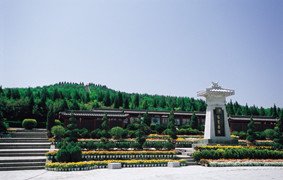
The Chinese ancestors believed there was an underground world that was the same as what they were alive, so they wanted to live the same life after death. Qin Shihuang also wanted to take all of his belongs to the underground world, so he ordered to build a magnificent mausoleum for himself. As early as he annexed the principalities in 221 BC, he had more than 700,000 conscriptsgathered from all parts of the country to build the mausoleum for him. And it took 37 years to complete the construction work.
The mausoleum was originally 120 meters tall, but after 2000 years erosion, it now only had 46 meters tall. According to a book ‘Records of Historian’ written by a great scholar Si Maqian in the Western Han Dynasty, the mausoleum was extremely luxurious. The outer coffin was cast in molten copper, and the burial chamber was complete with palaces, halls and towers. Fineutensils, precious stones and other ratites were everywhere. Automatic crossbows were used to protect the mausoleum from robbery. Mercury was used to make rivers and seas while pears and gems were used to make the sky including the Sun, the stars, and the moon. The entire underground palace was presumably lit by whale oil lamps forever. Experts have confirmed that ever since 1982, there is active mercury activity inside the mausoleum. This proved the description in the book was right. Archaeologists have found the mausoleum has not been plundered or even broken into. It is still remains us a mystery and we believe it would be another wonder in China and the whole world!
How the terra-cotta warriros and horses were found?
In 1974, when several farmers were sinking a well about 1.5 kilometers away east of the Qin Shihuang’s mausoleum, pottery fragments and bronze weapons were discovered accidentally.Excavations show it was an oblong pit with terracotta warriors and horses. In 1976, two more pits were discovered north of the former one. They were then named as Pit One, Pit Two and Pit Three by the order of discovery. The three pits cover an area of 22, 780 square meters, with presumably more than 7,000 warriors, 600 horses, hundreds of chariots, and thousand of hundreds of weapons. The discovery amazed the world.
Pit One
Pit one is the biggest pit. It takes an oblong shape. It is 230 meters long, 62 meters wide and five meters deep. It covers an area of 14,260 square meters.
Separated by ten original walls, the warriors and horses in the corridors are arrayed in battle formation. The three rows of warriors armed with bows and arrows and facing east is the vanguard of the army. The warriors in the west end of the pit are considered as the rear guard. Those who face north and south respectively are the flanks. Most of them hold crossbows or arrows, because they played a role as the whole army defender and were the main body of the formation. It is said after whole excavation and restoration, altogether 6,000 terracotta warriors and horses could be unearthed here.
The average height of the warriors is 1.8 meters and each one has different expressions and gestures. Some are smiling, some are serious, and some are waiting for army orders. Theirmoustache, hair styles and closes are also different from each other. This showed the Qin artisans had supreme technical to carve so exquisitely.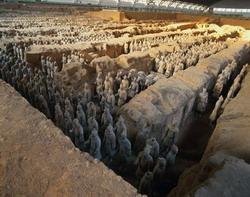
Most parts of the warriors were made by hand, including the feet, shoes, legs and armors. The warriors weights differently. The lightest is less than 110 kilograms while the heaviest is more than 300 kilograms. This is because some parts of the warriors are hollow while some are solid. The hollow parts were made through a method called ‘coiling clay rope’ while the solid parts were made separately. The most complex technique of the process is the making of the heads.Two molds were used firstly to make faces and most parts of the heads, and the two parts werejointed together. Ears and noses that are made separately were then joined on. Then the artisans carved different expressions on the roughly made faces according to each figure’s personal strata and characters. Finally moustache and hair were added. The completed clay figures were thenput into kiln for baking and then the baked warriors were carefully painted with colors. As the figures have been burnt in the civil rebellion at the end of Qin dynasty and they also gone through a natural process of decay, we can not see the gorgeous colors now, but a few of figures still bear the traces of the original colors.
Pit Two
Pit Two is still under excavation, but the battle formation is quite clear. It is 6,000 square meters large and in “L” shape. In the south part, there are eight passways forming a chariots formation. The west part is the combined battle formation of infantries, charioteers, and cavaliers. The north part is a cavalry formation and the northeast is an archer formation. The four parts are closely connected to constitute a complete battle formation and can be divided up to act independently, capable of attacking, defending and quick response.
Archeological findings show that Pit One and Pit Two were destroyed by a big fire. There are clear fire traces on the wall. It is still unknown when it was burnt down and who did it. Some one said that it was done by a farmer leader called Xiang Yu in the rebellion at the end of the Qin Dynasty. He once fired the Qin Epang Palace and entered the pits to rob weapons here.
Some ty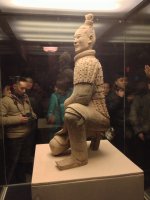 pical terracotta warriors were unearthed and exhibited there, including a knelling archer, a middle official, a general, a cavalry with a horse and a standing archer in the gesture of pulling a crossbow. All of them are the most beautiful an compelte warroris we found on the site and each has unique features.
pical terracotta warriors were unearthed and exhibited there, including a knelling archer, a middle official, a general, a cavalry with a horse and a standing archer in the gesture of pulling a crossbow. All of them are the most beautiful an compelte warroris we found on the site and each has unique features.
Weapons excavated from the pits are also exhibited here. Qin’s weapons can be divided into four kinds. One is the short weapons such as swords and broad knives. Another one is the long-shaft weapons such as spears, dagger-axes, halberds. The third one is the long-range weapons such as crossbows and arrows. The final one is the weapon for guards of honor like the Shu discovered in Pit Three. The most arresting among the weapons is this bronze sword. Although buried for over 2,000 years, it is still sharp enough to cut through 20 pieces of paper at one time. Experts have found it was coated with a thin layer of oxidated chromium, which helps to preserve its sharpness. The technology of chromium coating was invented by a German in the 1930s, but in China this technique was employed in the making of weapons 2,000 years ago. It is really a wonder and compels admiration.
Pit Three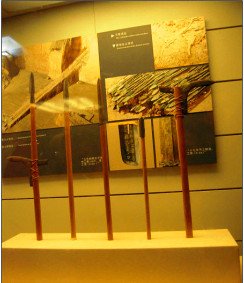
Pit Three is located 25 meters to the north of the Pit One, totaling about 520 square meters. This is the smallest pit among the three pits. One chariot, four terracotta horses and 68 terracottawarriors were unearthed here. To its east is a slope entrance, opposite which is a stable. Oneither side of the stable there is a winging room. Sixty-four terracotta warriors were unearthed from the two rooms. Warriors in this pit stand in different arrays from those in Pit One. They are arrayed opposite to each other along the walls in two rooms. Experts guessed they were the guards of the main generals. Only one kind of weapon was unearthed in this pit. It is called Shu without blades, and is believed to be used by the guards of honors. Also there have been unearthed several animal bones that were used for war pray in ancient times. Judging from the layout of this pit, this is most likely to be the headquarter of the entire underground army.
Exhibition Hall of Bronze Chariots and Horses
In December 1980, archeologists found a large pit holding two sets of painted bronze chariots and horses pieces 20 meters west of the Qin Shihuang’s tomb. When discovered, the bronze chariots and horses were broken into about 3,000 pieces in a large wooden coffin. They stand up after restoration for eight years. The bronze chariots and horses are the largest, most exquisite, and best preserved bronze wares discovered in the world so far.
The two bronze chariots are found to be the chariots for Emperor Qin to go out in his after death life. They were modeled after the real chariots, horses and drivers, but made in half size. Many gold and silver were used as ornaments. The two chariots are both drawn by four horses and with a single shaft.
The first one is called High Chariot. It is 2.57 meters long and weighs about 1,061 kilograms. It is equipped with crossbows, arrowhead and shields, showing us it is used to protect the one behind it. The horses’ tassels were made of bronze thread as thin as hair, whose diameter is only 0.1 millimeter. The horse necklaces were welded together with 42 nodes of gold and 42 nodes of silver. The welding joints could only be seen with a magnifier. The horses halters, made up of a gold tube and a silver tube, were joined with snap fasteners.
There is a arrow quiver on the left hand of the protecting board beside the charioteer. 12 bronze arrows are laid there ready for shooting any time. The charioteer is wearing a headgear and armed with a sword, decorated with a jade ring at the waist.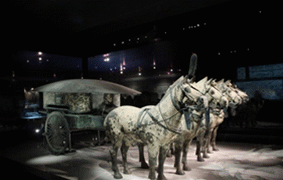
The second one is called Comfortable Chariot. It is about 3.17 meters long and weighs about 1,241 kilograms. The carriage was divided into a front chamber and a back chamber. The front one is for a sitting charioteer riding the carriage. The back chamber is quite spacious. The window panels are cast into shallow diamond-flower holes, which are neatly aligned into rhombic patterns. The holes are used for ventilation, so this chariot is also called Air-conditioned Chariot.The windows can be opened and closed flexibly up till now. The roof of the carriage is a turtle-shell canopy that is only four millimeter thick.
The excavation of the bronze chariots and horses provides valuable material and data for the research of the metallurgical technique, the mechanism and technological modeling of chariots in the Qin dynasty.
Tips
|
Location
|
Qinling Road, Lintong District, Xi’an
|
|
Drive Distance
|
45km to the east of the center of Xi’an, about one hour drive
|
|
Opening Time
|
Mar 16th- Nov 14th: 8:30 to 17:30
|
|
Nov15th – Mar 15th: 8:30 to 17:00
|
|
Ticket Price
|
Mar-Nov: RMB 150yuan per person
|
|
Dec-Feb: RMB 120yuan per person
|
|
Visiting Time
|
Around two and half hours
|






 Brief Introduction
Brief Introduction



 pical terracotta warriors were unearthed and exhibited there, including a knelling archer, a middle official, a general, a cavalry with a horse and a standing archer in the gesture of pulling a crossbow. All of them are the most beautiful an compelte warroris we found on the site and each has unique features.
pical terracotta warriors were unearthed and exhibited there, including a knelling archer, a middle official, a general, a cavalry with a horse and a standing archer in the gesture of pulling a crossbow. All of them are the most beautiful an compelte warroris we found on the site and each has unique features.



